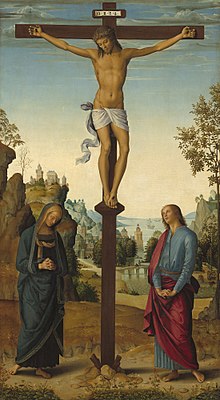| Works/Mp3 Description |
Genres
Stabat mater: Description |
| Buy cd's at Amazon Buy sheetmusic at SheetMusicPlus |
Stabat Mater is a thirteenth century Roman Catholic sequence (poem) variously attributed to Innocent III[1] and Jacopone da Todi.[2] Its title is an abbreviation of the first line, Stabat mater dolorosa ("The sorrowful mother stood"). The hymn, one of the most powerful and immediate of extant medieval poems, meditates on the suffering of Mary, Jesus Christ's mother, during his crucifixion. It is sung at the liturgy on the memorial of Our Lady of Sorrows. It has been set to music by many composers, with the most famous settings being those by Palestrina, Pergolesi, Haydn, Rossini, and Dvořák.
Text and translationThe following translation is not word-for-word. Instead it has been adapted so as to represent the meter (trochaic tetrameter), rhyme scheme, and sense of the original text. A literal translation (word-for-word, without concern for adaptation into the target language) can be found here.
Stabat Mater SpeciosaThere also exists a Christmas counterpart to the Stabat Mater, entitled Stabat Mater Speciosa ("The beautiful mother stood").[1] Musical settings
Composers who have written settings of the Stabat Mater include Josquin des Prez, Giovanni Pierluigi da Palestrina and Giovanni Battista Pergolesi; of the latter's setting, the German poet Tieck opined: "I had to turn away to hide my tears, especially at the place, 'Vidit suum dulcem natum'".[3] Joseph Haydn's Stabat Mater is considered "a treasury of refined and graceful melody".[4] Others who have written settings are Steffani, Clari, Emanuele d'Astorga, Winter, Raimondi, Vito, Lanza, Neukomm. In the 19th century, Gioacchino Rossini wrote his setting after retiring from the composition of opera, while Antonín Dvořák wrote his setting when he was still active in writing secular music. Most of the settings are in Latin, but Karol Szymanowski's setting is in Polish. Others: John Browne, Marc-Antoine Charpentier, Antonio Vivaldi, Charles Villiers Stanford, Charles Gounod, Krzysztof Penderecki, Francis Poulenc, Alessandro Scarlatti (1724), Domenico Scarlatti (1715), Pedro de Escobar, František Tůma, Vladimir Martynov, Arvo Pärt, Josef Rheinberger, Franz Schubert, Giuseppe Verdi, Pasquale Cafaro, Zoltán Kodály, Trond Kverno (1991), Pawel Lukaszewski (1994), Frank Ferko (1999), Salvador Brotons (2000), Hristo Tsanoff, Bruno Coulais (2005), the black metal band Anorexia Nervosa, the symphonic metal band Epica on the album The Classical Conspiracy, Karl Jenkins, and most recently the Finnish (one man) Funeral Doom band Stabat Mater (2009).
See alsoReferences
External links | |||||||
This article is licensed under the GNU Free Documentation License. It uses material from the Wikipedia article "Stabat mater". Allthough most Wikipedia articles provide accurate information accuracy can not be guaranteed. |
Help us with donations or by making music available!
©2023 Classic Cat - the classical music directory

Mozart, W.A.
Piano Sonata no. 10 in C major
Vadim Chaimovich
Dvořák, A.
Gypsy Songs
Jennifer Johnson Cano
Mozart, W.A.
Concerto for Flute & Harp
Mary Angelina Mei
Verdi, G.
Nabucco
Choeur Des Marias
Mozart, W.A.
Requiem
Vienna Philharmonic
Verdi, G.
Nabucco
Choeur Des Marias


